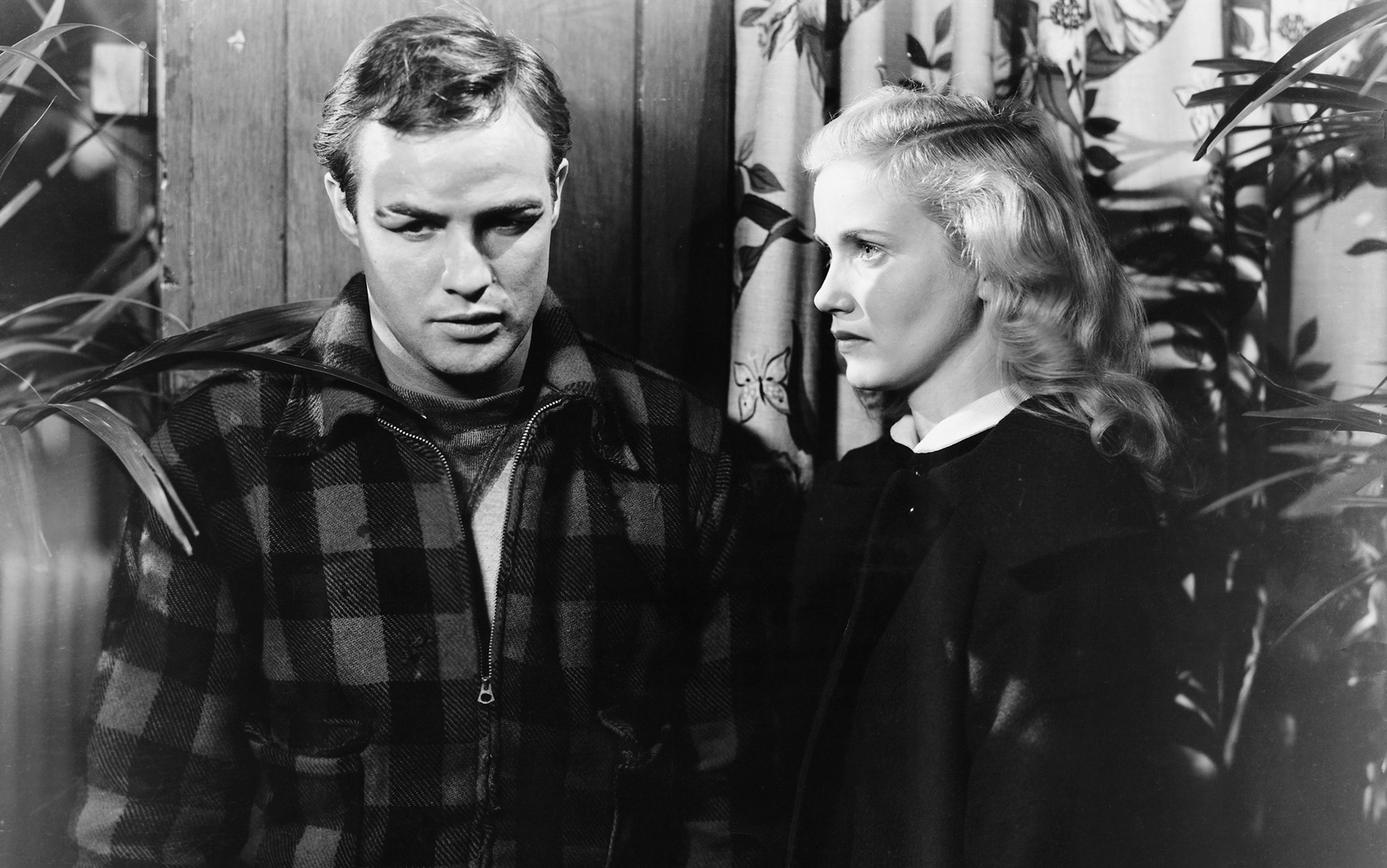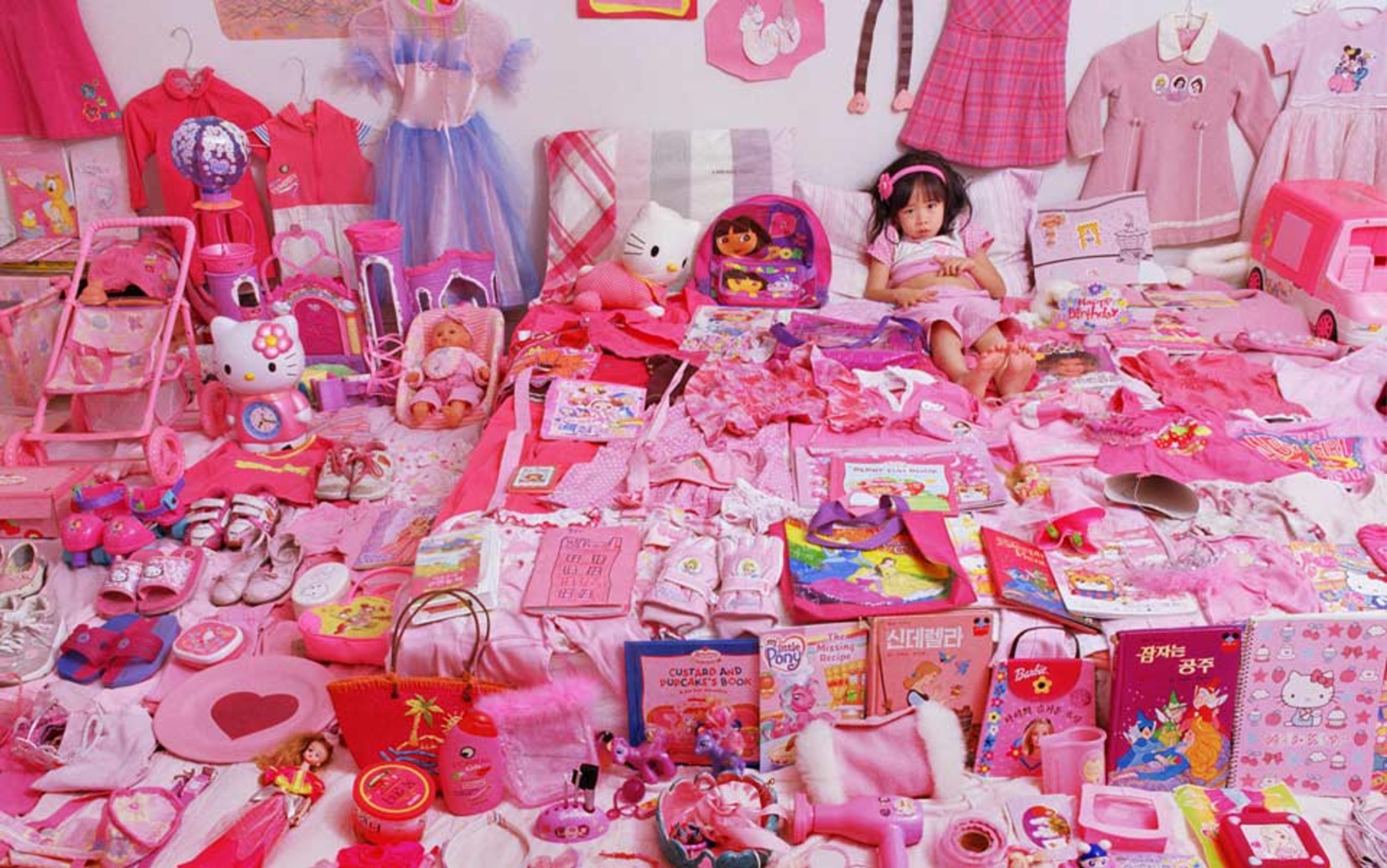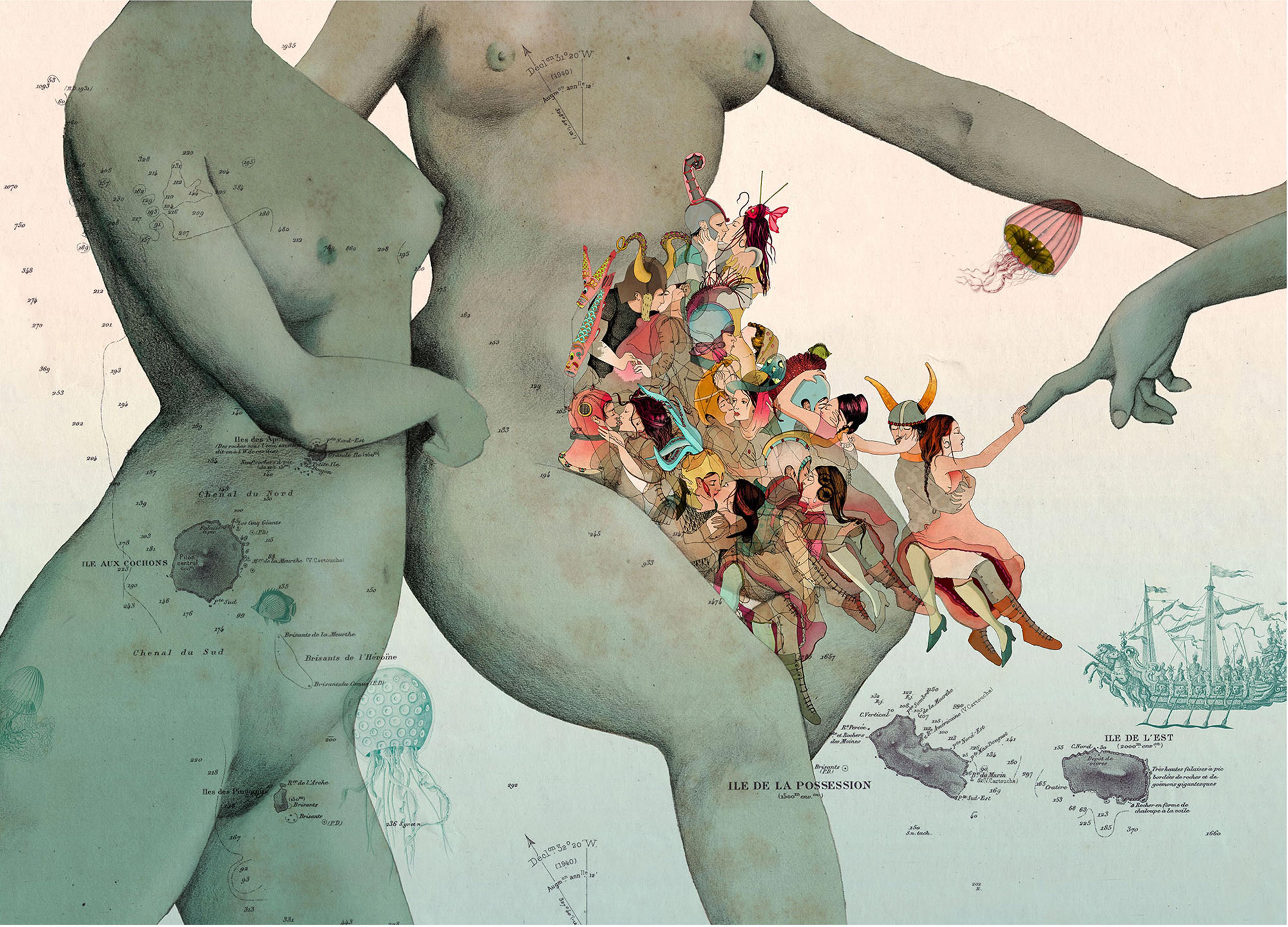If anything characterises the 21st-century social signalling of sex differences, it is the increased emphasis on ‘pink for girls and blue for boys’, with female ‘pinkification’ probably carrying the most strident message. Clothes, toys, birthday cards, wrapping paper, party invitations, computers, phones, bedrooms, bicycles – you name it, the marketing people seem prepared to ‘pinkify’ it. The ‘pink problem’, now quite often with a hefty helping of ‘princess’ thrown in, has been the subject of concerned discussion in the past decade or so.
Peggy Orenstein wrote about it in her book Cinderella Ate My Daughter: Dispatches from the Front Lines of the New Girlie-Girl Culture (2011), noting that there were more than 25,000 Disney Princess products on the market. The topic of this rampant pinkification has been frequently criticised, in books such as this and many others, so I had thought that I might not have to cover the pink issue again. But unfortunately for us all, this is a whack-a-mole problem and it shows little evidence of disappearing any time soon.
For a talk I was giving recently, I was mining the internet for examples of those dreadful pink ‘It’s a Girl’ cards when I came across something even more jaw-droppingly awful: ‘gender reveal’ parties.
If you haven’t already heard of these, they go something like this: at about 20 weeks into a pregnancy, it is usually possible to tell the sex of the child you are expecting from an ultrasound scan, thus, apparently, triggering the need for an expensive party. There are two versions, and both are a marketing dream. In version 1, you decide to remain in ignorance, and instruct your ultrasound technician to put the exciting news in a sealed envelope and send it to your gender-reveal party organiser of choice. In version 2, you find out for yourself but decide to break the news at the party. You then summon family and friends to the event via invites bearing a question such as ‘A bouncing little “he” or a pretty little “she”?’, ‘Guns or Glitter?’ or ‘Rifles or Ruffles?’
At the party itself, you might be confronted with a white iced cake that can be cut open to reveal blue or pink frosting (it might also be decorated with the words ‘Buck or Doe? Cut to know’). Or there could be a sealed box that, when opened, will release a flotilla of pink or blue helium-filled balloons; a wrapped outfit from your nearest nursery store that will be opened to reveal the pink or blue creation into which you will stuff your newborn; even a piñata that you and your guests can hammer away at until it releases a flood of pink or blue candy. There are guessing games that appear to involve toy ducks (‘Waddle it be?’) or bumblebees (‘What will it bee?’), or some sort of raffle where, on arrival, you put your guess in a jar and win a prize once the reveal is made. Or (the frontrunner for the most tasteless) you are given an ice cube containing a plastic baby, and in a ‘my waters have broken’ race, you try to find the quickest way of melting your ice cube to reveal whether the baby is pink or blue.
So, 20 weeks before little humans even arrive into it, their world is already tucking them firmly into a pink or a blue box. And it is clear from the YouTube videos (yes, I became obsessed) that, in some cases, different values are attached to the pinkness or blueness of the news. Some of the videos show existing siblings watching the excitement of ‘the reveal’ and it’s hard not to wonder what the three little sisters made of the screams of ‘At last!’ that accompanied the cascading blue confetti. Just a harmless bit of fun, maybe, and a marketing triumph, for sure, but it is also a measure of the importance that is attached to these ‘girl’/‘boy’ labels.
Even efforts to level the playing field get swamped in the pink tide – Mattel has produced a STEM Barbie doll to stimulate girls’ interest in becoming scientists. And what is it that our Engineer Barbie can build? A pink washing machine, a pink rotating wardrobe, a pink jewellery carousel.
You might wonder why any of this matters. What it all comes down to is the debate over whether pinkification is signalling a natural biological divide or reflecting a socially constructed coding mechanism. If it is really the sign of a biological imperative, then perhaps it should be respected and supported.
But if we’re looking at a social set-up, then we need to know if the associated binary coding is still serving the two groups well (if it ever did). Are our journeying girl brains helped out by being directed away from construction toys and adventure books, and those of their boy counterparts from cooking sets and dolls’ houses?
Perhaps we should ask whether the power of the pink tide has a biological basis. In 2007, a team of vision scientists suggested that this preference was linked to an ancient need for the female of the species to be an effective ‘berry gatherer’. Responsiveness to pink would ‘facilitate the identification of ripe, yellow fruit or edible red leaves embedded in green foliage’. An extension of this was the suggestion that pinkification is also the basis of empathy – aiding our female caregivers to pick up those subtle changes in skin tone that match emotional states. Bearing in mind that the study, carried out on adults, used a simple forced-choice task involving coloured rectangles, this is quite a stretch, but it clearly struck a chord with the media, who hailed the finding as proof that women were ‘hardwired to prefer pink’.
However, three years later the same team carried out a similar study in four- to five-month-old infants, using eye movements as a measure of their preference for the same coloured rectangles. They found no evidence of sex differences, with all babies preferring the reddish end of the spectrum. This finding was not accompanied by the media flurry that greeted the first one. The study with adults has been cited more than 300 times as support for the notion of ‘biological predispositions’. The study with infants, where no sex differences were found, has been cited 61 times.
Parents will still exclaim that there must be something fundamental about this preference for pink when they find that, despite their best efforts at ‘gender-neutral parenting’ for their daughters, all is swept away by the pink-princess tide. Children as young as three will allocate genders to toy animals based on their colour; pink and purple ones are girl animals, and blue and brown ones are boy animals. Surely, there must be a biological driver behind the emergence of a preference this early and this determined?
But a telling study from the American psychologists Vanessa LoBue and Judy DeLoache tracked more closely just how early this preference emerges. Nearly 200 children, aged seven months to five years, were offered pairs of objects, one of which was always pink. The result was clear: up to the age of about two, neither boys nor girls showed any kind of pink preference. After that point, though, there was quite a dramatic change, with girls showing an above-chance enthusiasm for pink things, whereas boys were actively rejecting them. This became most marked from about three years old onwards. This tallies with the finding that, once children learn gender labels, their behaviour alters to fit in with the portfolio of clues about genders and their differences that they are gradually gathering.
Gender-related colour-coding was established 100 years ago, and seems to vary with fashion
What about the evidence of a pink/blue divide being a culturally determined coding mechanism? Why (and when) pink became linked to girls and blue to boys has been a matter of earnest academic debate. One side has claimed that this used to be the other way round, and that, until the 1940s, blue was actually seen as the appropriate colour for girls, possibly because of its links with the Virgin Mary. This idea has been critiqued by the psychologist Marco Del Giudice at the University of New Mexico who, after a detailed archive search via Google Books Ngram Viewer, said he found little evidence of the blue-for-girls/pink-for-boys claim. He dubbed this the pink/blue reversal and, naturally, an acronym (PBR) has followed; he’s even awarded it the status of a ‘scientific urban legend’.
But the evidence for some kind of cultural universality for pink as a female colour is not that powerful either. Examples from Del Guidice’s own review suggests that any kind of gender-related colour-coding was established little more than 100 years ago, and seems to vary with fashion, or depending on whether you were reading The New York Times in 1893 (‘Finery For Infants: Oh, pink for a boy and blue for a girl’) or the Los Angeles Times in the same year (‘The very latest nursery fad is a silky hammock for the new baby … First on the net is laid a silk quilted blanket, pink for a girl, blue for a boy’).
In terms of understanding the significance of pinkification for our journeying brains, the key issue is not, of course, pink itself but what it stands for. Pink has become a cultural signpost or signifier, a code for one particular brand: Being a Girl. The issue is that this code can also be a ‘gender segregation limiter’, channelling its target audience (girls) towards an extraordinarily limited and limiting package of expectations, and additionally excluding the non-target audience (boys).
Paradoxically (and in fairness to the other side of the argument), sometimes pink appears to serve as a kind of social signature that ‘gives permission’ for girls to engage with what would otherwise be seen as a boy domain. But, as STEM Barbie suggests, pinkification is all too often linked with a patronising undertow, where you can’t get females to engage with the thrills of engineering or science unless you can link them to looks or lipstick, ideally viewed through – literally – rose-tinted glasses.
The whole issue of the increased gendering of toys and the contribution that this is making to the sustaining of stereotypes has been the focus of much concern in recent years, even to the extent of the White House holding a special meeting to discuss it in 2016. Might toy choice be a major chicane for our journeying brains? Or have they already been set on this route before birth? Do toy choices reflect what is going on in the brain? Or do they determine what is going on in the brain?
Researchers can be pretty firm about the status quo in this aspect of children’s behaviour: ‘Girls and boys differ in their preferences for toys such as dolls and trucks. These sex differences are present in infants, are seen in nonhuman primates, and relate, in part, to prenatal androgen exposure.’ This statement, from researchers at the University of Cambridge in 2010, neatly encapsulates the sets of beliefs about toy choice in children, so let’s explore the story of toys, who plays with what and why – and whether it matters at all.
The issue of toy preference has acquired the same kind of significance as the pink/blue debate. From a fairly young age, possibly as young as 12 months, it appears that boys and girls show preferences for different kinds of toys. Given the choice, boys are more likely to head for the truck or gun box, whereas girls can be found with dolls or cooking pots. This has been adopted as evidence for several different arguments. The essentialist camp, supported by the hormone lobby, would claim that this is a sign of differently organised brains following their differently channelled pathways; for example, an early preference for ‘spatial’ or construction-type toys is an expression of a natural ability.
The social-learning camp would claim that gendered toy preference is the outcome of children’s behaviour being modelled or reinforced in gender-appropriate ways; this could arise from parent or family gift-giving behaviour or it could be the outcome of a powerful marketing lobby determining and manipulating their target market.
Who actually decides what is a ‘boy toy’ and what is a ‘girl toy’?
A cognitive-constructionist camp would point to an emerging cognitive schema, where fledgling gender identities latch on to objects and activities that ‘belong’ to their own sex, scanning their environment for the rules of engagement that specify who plays with what. This would suggest a link between the emergence of gender labelling and the emergence of gendered toy choice.
And there are yet other arguments about the consequences of toy preference. If you spend your formative years playing with dolls and tea sets, will that steer you away from the useful skills that playing with construction kits or playing target-based games might bring you? Or might these different activities just be reinforcing your natural abilities, offering you appropriate training opportunities and enhanced talents for the occupational niche that will be yours? Looking particularly at the 21st century, if the toys you play with carry the message that appearance, and quite often sexualised appearance at that, is the defining factor of the group you belong to, does that have different consequences from playing with toys that offer the possibility of heroic action and adventure?
And might any of these consequences be found not only at the behavioural level but also at the brain level? As ever, the causes and consequences issues are entangled. If gendered toy preference is an expression of a biology, then the interpretation tends to be that it is inevitable and shouldn’t be interfered with, and that those who challenge it should be sent away with the mantra ‘Let boys be boys and girls be girls’ ringing in their ears. Specifically for researchers, it would mean that sex differences in toy preference could be a very useful index of sex differences in underlying biology, a genuine brain-behaviour link. On the other hand, if gendered toy preference is actually a measure of different environmental input, it would be possible to measure the different impacts of that input and, perhaps more importantly, the consequences of changing it.
However, before we launch into the pros and cons of the various theories attached to toy preference, we need to look at the actual characteristics of these differences. Is it a robust difference, reliably found at different times, in different cultures (or even just in different research studies)? Who actually decides what is a ‘boy toy’ and what is a ‘girl toy’? Is it the children who play with them or the adults that supply them? In other words, whose preferences are we actually looking at?
Among adults, there appears to be pretty widespread agreement as to what constitutes male-typed, female-typed and neutral toys. In 2005, Judith Blakemore and Renee Centers, psychologists from Indiana, got nearly 300 US undergraduates (191 females, 101 males) to sort 126 toys into ‘suitable for boys’, ‘suitable for girls’, or ‘suitable for both’ categories. Based on these ratings, they generated five categories: strongly masculine, moderately masculine, strongly feminine, moderately feminine, and neutral. Interestingly, there was fairly universal agreement between males and females about the toys’ genders. There were ratings disagreements about only nine of the toys, with the largest difference concerning a wheelbarrow (rated as strongly masculine by men and moderately masculine by women); similarly, there was a bit of arm-wrestling over toy horses and hamsters (rated moderately feminine by men and neutral by women), but there were no incidences of cross-gendering. So it would appear that ‘toy typing’ is pretty clear-cut in adult minds.
And do children agree with these ratings? Do all boys choose boy toys, all girls choose girl toys? Brenda Todd, a psychologist from City, University of London, researches children’s play, and decided to study their behaviour with toys from dolls to cars. Do all little boys obligingly head for the car/digger/ball/blue teddy bear? And all little girls for the doll/cooking pot/pink teddy bear?
To find out, she tested three groups of children, aged nine to 17 months (identified as the age when children first start to engage in independent play), 18 to 23 months (when children show signs of acquiring gender knowledge), and 24 to 32 months (when gender identities become more firmly established). Among the findings: boys were more obliging to the researchers in picking the ‘boy toys’, showing a steady age-related increase in the amount of time they played with the car and the digger. If you’re wondering what happened to the blue teddy bear and the ball, the researchers decided (post hoc) to drop the former as there was ‘no significant sex difference in play’. They also decided to drop the pink teddy bear because the older children didn’t play with either bear. And they then noticed that there were an uneven number of toys in their two categories, so they also dropped the ball (even though it actually showed a sex difference, with boys playing with it more than girls). So now it was the car and digger versus the doll and cooking pot – this meant the odds were stacked in favour of the most gender-targeted toys.
The study revealed an element of self-fulfilling prophecy: boys played longer with the toys that had been labelled ‘boy toys’, and the girls with the ‘girl toys’. Interestingly, there was a little twist in the overall picture. For boys, a steady increase in play with boy toys paralleled a decrease in play with girl toys, but the story was different for girls. Although the younger girls appeared to be more interested in girl toys than boys were in boy toys, this interest wasn’t sustained in the middle group, where there was actually a drop in the amount of time they spent with girl toys. In fact, girls showed an increase in the amount of time they played with boy toys as they got older.
So, even though the researchers cheerfully admitted to ‘stacking the odds’ with respect to the gender-labelling of the toys they used, their little participants did not show the kind of neat dichotomy that might be expected. Given the emphasis put on toy choice as a powerful index of the essential nature of gender differences, together with the contemporary insistence from the gendered-toy marketing lobby that they are merely reflecting the ‘natural’ choices of boys and girls, this kind of nuance in the whole toy-story saga should really be given more air time.
Girls heading for the toy trucks? No problem! Boys selecting a tutu? Hold on a second
Perhaps the matter might be settled by a recent research article that reports a combination of a systematic review and a meta-analysis of studies in this area. The article looked at 16 different studies, encompassing 27 groups of children (787 boys and 813 girls) overall. If anything could confirm the reliability, universality and stability of toy preference, might this be it?
The overall conclusion was that boys played with male-typed toys more than girls, and girls with female-typed toys more than boys. But we were not given any details about what these toys were or who decided their ‘gender’. Nor were we given any information about whether the children had siblings, and what kind of toys were found in their home environment. Bear this in mind when considering one of the review’s overall conclusions that ‘the consistency in finding sex differences in children’s preferences for toys typed to their own gender indicates the strength of this phenomenon and the likelihood that [it] has a biological origin’. An additional force we might need to consider is the messages our little gender detectives are picking up about what they are ‘allowed’ to play with, given the assumption in the kind of studies we have looked at above that children are given a free toy choice. But even if they are supposedly given free rein, it is not necessarily symmetrical. Girls heading for the toy trucks? No problem! Boys selecting a tutu from the dressing-up box? Hold on a second.
Even if there is an overtly egalitarian message, children are pretty astute at picking up the truth. A small-scale study by Nancy Freeman, a teacher-education expert from South Carolina, illustrated this neatly. Parents of three- to five-year-old children were quizzed on their attitudes to childrearing, and were asked to indicate their agreement or disagreement with statements such as ‘A parent who would pay for ballet lessons for a son is asking for trouble,’ or ‘Girls should be encouraged to play with building blocks and toy trucks.’ Their children were then asked to sort a pile of toys into boy toys and girl toys, and also to indicate which toys they thought their father or mother would like them to play with. There was agreement about which toys were which, divided along predictably gendered lines, with further agreement of parental approval for playing with matched-gendered toys: tea sets and tutus for the girls; skateboards and baseball mitts for the boys (yes, some of these children were only three years old).
Where the disconnect emerged was that these little children had very clear understanding of what level of approval they would get for playing with a ‘cross-gendered’ toy. So, for example, only 9 per cent of five-year-old boys thought that their father would approve of them choosing a doll or a tea set to play with, whereas 64 per cent of the parents had claimed they would buy their son a doll, and 92 per cent didn’t think ballet lessons for boys were a bad idea. With a rule-scavenging brain on the lookout for gender clues, these children have either misread the message or, as Freeman proclaims in the title of her paper, are good at picking up ‘hidden truths’.
What happens if you deliberately invent the labels of toys as ‘for boys’ or ‘for girls’? This was tested on another group of three- to five-year-olds; 15 girls and 27 boys. Children were presented with a shoe shaper, a nutcracker, a melon baller and a garlic press, either in pink or blue, with the objects randomly labelled ‘for girls’ or ‘for boys’. Children were asked how much they liked the toys and who they thought would like and play with them. Boys were much less affected by either the colour or the labels, rating them all as just about equally interesting. Girls, however, were much more gender-label compliant at one level, quite strongly rejecting the blue boy toys and approving of the pink girl toys. But they also showed a significant shift in approval rating for so-called boy toys if they were painted pink, for example, earnestly indicating that other girls might just like the ‘boyish’ garlic press if it could be produced in pink. The authors describe this as a ‘giving girls permission’ effect, where the effect of boy labelling can be counteracted with a girlish colour wash. What a dream result for the marketing industry!
So, with respect to toys at least, girl choices do seem to be affected more by the social signals, in this case verbal and colour gender labels. Why might the same not be true for boys – why would they not be equally enthused by a ‘girly’ melon baller if they could have it in blue? Could it be that, while girls are generally not discouraged from playing with boy toys, and, indeed, might occasionally be given permission to pick up the odd hammer (as long as it has a soft pink handle, of course), the reverse is not the case, with evidence of active intervention, particularly from fathers, if boys appear to be choosing to play with girl toys?
The extreme gendering of toys as a recent phenomenon has received much attention. Those of us who had our children in the 1980s and ’90s feel that the marketing of toys to their children is much more gendered now than it was then. According to Elizabeth Sweet, a sociologist in San Jose who has made a detailed study of the history of toy marketing, this might be because we were then experiencing the effects of the second wave of feminism. She points out that there was clear evidence of gendered toy marketing in the 1950s with a focus on fitting little humans into their stereotypical roles – toy carpet-cleaners and kitchens for the girls, construction sets and tool kits for the boys. Between the 1970s and the ’90s, gender stereotypes were much more actively challenged, and this was reflected in more egalitarian toys (which could, of course, be good news for any attempts to reverse the gendered toy marketing trend). But that seems to have been swept away in recent decades, partly due, Sweet feels, to the deregulation of children’s television, so that children’s programmes could be commercialised and used as marketing opportunities, driving the ‘need’ for Rainbow Brite or She-Ra or the next Power Ranger.
It is clear that boys and girls play with different toys. But an additional question should be – why? Why do boys prefer trucks and girls dolls? Is there some kind of innate driver behind toy preference, or are children meekly complying with the social rules that their families, social media and marketing moguls are pressing upon them?
The answer to these questions could lie in our new understanding of how, from the moment of birth (if not before), our brains drive us to be social beings – to understand social scripts, social norms, social behaviour – to make sure we understand the groups we should belong to and how we can fit in. Like the deep learning systems powering artificial intelligence, our brains are scouring our world for the rules of the social game – and if that world is full of powerful messages about gender, helpfully flagged by all sorts of gendered labelling and gendered colour-coding, our brains will pick up such messages and drive their owners to behave ‘appropriately’. Babies come into the world like tiny social sponges, picking up social hints from the world around them – the sight of a familiar face, the sound of a familiar voice – and they rapidly turn into junior gender detectives, eagerly hunting for clues as to what being a girl or a boy means, what girls or boys should be wearing or what they should be playing with. If the answers to their questions bring different experiences, different expectations, then this will be reflected in their brains and their behaviour. A gendered world produces a gendered brain.
Copyright © 2019 by Gina Rippon. Extracted from the book ‘Gender and Our Brains: How Neuroscience Explodes the Myths of the Male and Female Minds’, published in the US by Pantheon, an imprint of The Knopf Doubleday Group, a division of Penguin Random House, LLC / ‘The Gendered Brain: The New Neuroscience That Shatters the Myth of the Female Brain’, published in the UK by The Bodley Head.






